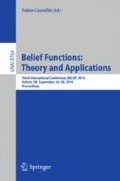Abstract
In this paper, classification of air vehicles according to their types is studied. Demspter-Shafer theory is utilized for this purpose. The target tracker data is used for obtaining the probability masses by comparing it with the prior information. Prior information is modeled as the probability density function of the features used for classification. The prior information models the selected features as Gaussian mixtures while the tracker data models the same features as non-parametric density. This new methodology is tested on real data.
The original version of this chapter was revised: The limits of the integrals in the equations (2-a), (2-c), (2-e), (2-g), (2-i), (2-k), (2-m), which are located in pages 395–397 are corrected. The erratum to this chapter is available at 10.1007/978-3-319-11191-9_48
Access this chapter
Tax calculation will be finalised at checkout
Purchases are for personal use only
Preview
Unable to display preview. Download preview PDF.
References
Bar-Shalom, Y.: Multitarget-multisensor tracking: Applications and advances, vol. III. Artech House, Inc., Norwood (2000)
Bendjebbour, A., Delignon, Y., Fouque, L., Samson, V., Pieczynski, W.: Multisensor image segmentation using Dempster-Shafer fusion in markov fields context. IEEE Transactions on Geoscience and Remote Sensing 39(8), 1789–1798 (2001)
Blackman, S., Popoli, R.: Design and Analysis of Modern Tracking Systems, pp. 967–1068. Artech House, Norwood (1999)
Bloch, I.: Some aspects of Dempster — Shafer evidence theory for classification of multi-modality medical images taking partial volume effect into account. Pattern Recogni-tion Letters 17(8), 905–919 (1996)
Caromicoli, A., Kurien, T.: Multitarget identification in airborne surveillance. In: International Society for Optics and Photonics Orlando Symposium (1989)
Florea, M.C., Jousselme, A.-L., Grenier, D., Bosse, E.: Combining belief functions and fuzzy membership functions. International Society for Optics and Photonics Aero-Sense 2003, 113–122 (2003)
Jane, F.: Jane’s all the world’s aircraft. McGraw-Hill (1999)
Jiang, W., Duanmu, D., Fan, X., Deng, Y.: A New Method to Determine Basic Probability Assignment under Fuzzy Environment. In: International Conference on Systems and In-formatics, pp. 758–762 (2012)
Le Hegarat-Mascle, S., Bloch, I., Vidal-Madjar, D.: Application of Dempster — Shafer evi-dence theory to unsupervised classification in multisource remote sensing. IEEE Transactions on Geoscience and Remote Sensing 35(4), 1018–1031 (1997)
Masson, M.H., Denoeux, T.: ECM: An evidential version of the fuzzy c-means algo-rithm. Pattern Recognition 41(4), 1384–1397 (2008)
Bogler, P.: Shafer-Dempster reasoning with applications to multisensor target identification systems. IEEE Transactions on Systems, Man and Cybernetics 17(6), 968–977 (1987)
Ristic, B., Smets, P.: Target identification using belief functions and implication rules. IEEE Transactions on Aerospace and Electronic Systems 41(3), 1097–1103 (2005)
Romer, C., Kandel, A.: Constraints on belief functions imposed by fuzzy random var-iables. IEEE Transactions on Systems, Man and Cybernetics 25(1), 86–99 (1995)
Salzenstein, F., Boudraa, A.: Unsupervised multi sensor data fusion approach. In: Sixth International Symposium on Signal Processing and its Applications, vol. 1, pp. 152–155. IEEE, Kuala Lumpur (2001)
Utkin, L.: Extensions of belief functions and possibility distributions by using the im-precise Dirichlet model. Fuzzy Sets and Systems 154(3), 413–431 (2005)
Xu, P., Deng, Y., Su, X., Mahadevan, S.: A new method to determine basic probability as-signment from training data. Knowledge-Based Systems 46, 69–80 (2013)
Yager, R.R.: A class of fuzzy measures generated from a Dempster — Shafer belief structure. International Journal of Intelligent Systems 14(12), 1239–1247 (1999)
Zhu, Y., Bentabet, L., Dupuis, O., Kaftandjian, V., Babot, D., Rombaut, M.: Automatic determination of mass functions in Dempster — Shafer theory using fuzzy c-means and spatial neighborhood information for image segmentation. Optical Engineering 41(4), 760–770 (2002)
Author information
Authors and Affiliations
Editor information
Editors and Affiliations
Rights and permissions
Copyright information
© 2014 Springer International Publishing Switzerland
About this paper
Cite this paper
Turhan, H.I., Demirekler, M., Gunay, M. (2014). A Novel Methodology for Target Classification Based on Dempster-Shafer Theory. In: Cuzzolin, F. (eds) Belief Functions: Theory and Applications. BELIEF 2014. Lecture Notes in Computer Science(), vol 8764. Springer, Cham. https://doi.org/10.1007/978-3-319-11191-9_43
Download citation
DOI: https://doi.org/10.1007/978-3-319-11191-9_43
Publisher Name: Springer, Cham
Print ISBN: 978-3-319-11190-2
Online ISBN: 978-3-319-11191-9
eBook Packages: Computer ScienceComputer Science (R0)

